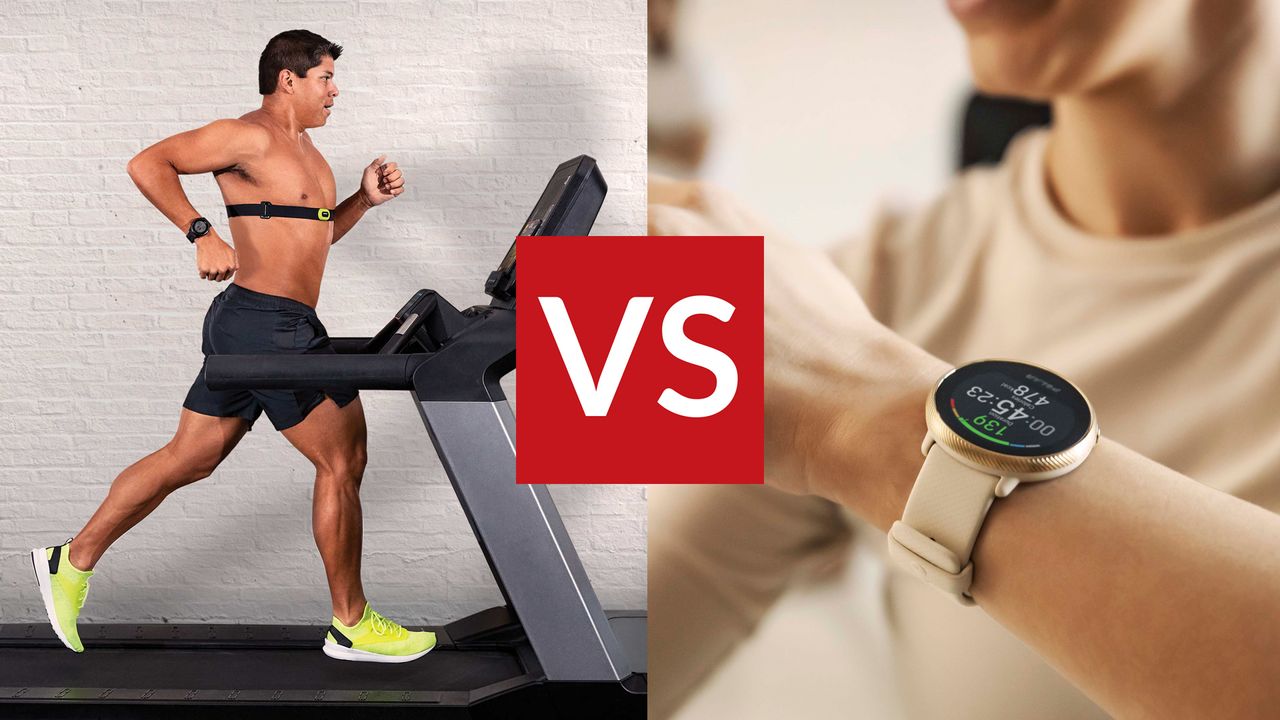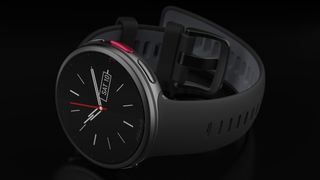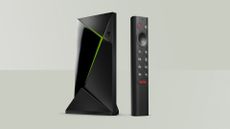

Heart rate monitor (or strap) versus running watch might seem like a rather one-sided contest. One can provide you with a wealth of metrics, and also tell you when you've received WhatsApp messages. The other is a sad little strap with a bit of plastic in the middle, which you have to clip around your upper torso like some kind of medical device.
However there is actually a lot to be said for monitoring your pulse during exercise from your chest. For a start your chest, as any doctor will tell you, is where your heart is.
Wearing a device that can measure heart rate during training can help you improve performance on the long run and if you are a serious athlete, the decision between what sort of fitness wearable to get comes down to this: heart rate monitor vs running watch. Should you get the best heart rate monitor that tracks heart rate the most accurately or get the best running watch you can find, and gain access to a variety of fitness features?
The decision might not be as simple as that and whether you should get a heart rate monitor or a running watch depends on not just what your chosen sport is, but also how you train and what data do you need to get better. There is also an argument for using both at the same time, something we'll discuss in detail below. Right at the bottom you will also find today's best heart rate monitor and running watch deals, in case you want to buy them today.
Heart rate monitor vs running watch: what are these wearables?
Running watches are probably a bit more well-known than heart rate monitors but we are fairly certain that most people can tell the difference between the two. Just to recap:
Heart rate monitors generally fall into two different categories: transmitter-type straps worn around the chest measuring ECG or optical heart rate sensors that can be worn elsewhere on the body, e.g. arm, temple etc. Heart rate straps usually don't have displays or a lot of different sensors and mainly focus on measuring heart rate as accurately as possible. An example of the transmitter-type heart rate strap is the Wahoo Tickr X and the optical sensor-type is the Polar Verity Sense. The main heart rate monitor brands are Garmin, Polar, Wahoo and MyZone.
Running watches – nowadays often called multisport watches – also have heart rate sensors (the optical variety) as well as a million other sensors and chips such as GPS, ABC sensors, temperature sensors and so on. Watchges tend to have a lot more features on board that can include music storage, smart notifications, training aid, coaching support and much more. Running watches almost always have a display that very often displays measurements real-time.
Sign up to the T3 newsletter for smarter living straight to your inbox
Get all the latest news, reviews, deals and buying guides on gorgeous tech, home and active products from the T3 experts
There are a lot of great running watches, including the Garmin Forerunner 945, Polar Vantage V2 and Coros Pace 2. The main running watch brands are Garmin, Polar, Suunto, Coros and to some degree, Fitbit.

Heart rate monitor vs running watch: features
Heart rate monitors are simple devices: they usually only measure heart rate. Well, that's not entirely true as most premium heart rate straps also measure certain running dynamics as well as being an essential tool to perform some of the tests available on running watches. The Garmin HRM-Pro is capable of measuring advanced running metrics such as vertical oscillation, ground contact time, stride length and vertical ratio while the Polar H10 is essential in performing the Polar Orthostatic Test found on high-end Polar watches.
On the other hand, running watches have more features than most smartphones (might be exaggerating here slightly). As well as measuring heart rate, these fitness wearables are also capable of tracking position (i.e. GPS), sleep, respiration, blood oxygen levels and so much more. Top-tier running watches have all the features you would expect from a smartwatch too: music storage and/or control on the wrist, smart notifications, weather updates, calendar function, Bluetooth and ANT+ connectivity etc.
Running watches have a few specific features that can only be found on these type of wearables (and sometimes on fitness trackers) including energy and stress monitoring, ECG measurements and breathing anomaly detection. Running watches sometimes have running coaching and recovery advisor features on board too.

Heart rate monitor vs running watch: ease of use
Given the simplicity of heart rate monitors, it's very easy to use them. Very often there aren't any buttons on the device either: all you have to do is wrap it around your chest and it's ready to go. While some heart rate straps have memory to store workouts, people often use the straps to record workouts straight into the accompanying apps: Garmin Connect, Wahoo App, Polar Beat or Polar Flow. Another option is when the heart rate straps are used with running watches to improve heart rate reading (more on this later).
People tend to wear running watches often, even when they aren't running or cycling, especially considering the range of smart features these wearables have to offer. Starting a workout with a running watch is not difficult, especially once you get used to the navigation scheme, but since you can customise the parametres and sensors for each workout, it can be considered more cumbersome to workout with a running watch as opposed to a heart rate monitor.
Some Garmin watches are infamous for having too many options which can confuse beginner users. The Garmin Fenix 6 Pro even have dedicated support for turbo trainers while the Garmin Enduro has a feature called '3D Speed and Distance' which takes elevation into account when calculating VO2 max. For the unacquainted athlete, it might be confusing to make sense all the different options on a running watch.

Heart rate monitor vs running watch: accuracy
When it comes to measuring heart rate, nothing really beats electrode pad/transmitter-type heart rate monitors. As long as the sensor's connection points are on the skin, it will measure heart rate accurately, regardless of what physical activity you are performing. Since heart rate monitor straps aren't worn on the wrist, this makes them the best tool to measure heart rate during vigorous resistance training workouts, especially when using kettlebells.
Running watches offer a 'jack of all trade, master of none' style accuracy. They measure heart rate relatively accurately – modern watches anyway, especially in higher heart rate zones – as well as elevation, pace, temperature, and most importantly, location. A good smartwatch should be able to measure this all with great accuracy but since you wear watches on your wrist, heart rate measurements will always depend on how the watch sits on your wrist, how clean the sensors are, how much hair is blocking the readings etc, not to mention skin tone and built up sweat.
Premium running watches are not inaccurate, by a long shot, they are just not as reliable as heart rate monitors. The margin of error is getting smaller as companies roll out more and more software updates and thanks to the advancement of sensor technology. Very often readings from an optical heart rate sensor are almost identical to the ones gained from a heart rate strap, but if you want the get best readings as often as possible, you are better off using a heart rate strap.

Heart rate monitor vs running watch: how about using BOTH?
This might be obvious for some but if heart rate monitors and running watches work well together. Very often they compliment each other and by wearing both for your running and cycling workouts, you can maximise the amount of data you gain from each session.
Better still, by using a heart rate monitor and a running watch from the same brand, you 'unlock' advanced metrics that are also more accurate than when you pair wearables from different brands. A good example is using a Garmin Forerunner 745 with the HRM-Pro strap: you can access advanced running metrics as well as being able to perform the Garmin Lactate Threshold Test. Similarly, combining the Polar H10 with the Polar Vantage V2 will turn the pair into the ultimate training load and recovery tool.
Heart rate monitor vs running watch: price and availability
Heart rate monitors are usually way cheaper than running watches: Prices start from as low as $75/£65 for a decent strap. Even the best heart rate monitors won't cost you more than $110/£100.
Running watches can be pretty expensive but some of the simpler models can be acquired for as little as $200/£200. As a matter of fact, the very competent Coros Pace 2 can be yours for way less than that. Mid-range watches, such as the Polar Vantage M2, are around $300/£300 while high-end watches can cost as much as a flagship smartphones: the price of the Garmin Enduro starts from $800/£700.

Matt Kollat is a journalist and content creator who works for T3.com and its magazine counterpart as an Active Editor. His areas of expertise include wearables, drones, fitness equipment, nutrition and outdoor gear. He joined T3 in 2019. His byline appears in several publications, including Techradar and Fit&Well, and more. Matt also collaborated with other content creators (e.g. Garage Gym Reviews) and judged many awards, such as the European Specialist Sports Nutrition Alliance's ESSNawards. When he isn't working out, running or cycling, you'll find him roaming the countryside and trying out new podcasting and content creation equipment.
-
 This smart tracking device has something Apple's AirTag can't match – and it's very affordable too
This smart tracking device has something Apple's AirTag can't match – and it's very affordable tooKickstarter project could shake up the Find My market
By Britta O'Boyle Published
-
 Nvidia Shield TV gets its biggest free experience update in years
Nvidia Shield TV gets its biggest free experience update in yearsNvidia continues to support its Android TV streaming box, which is still one of the best around
By Rik Henderson Published